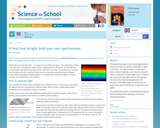
In this lesson, students construct a simple spectrometer from a cereal box and a CD and use it to investigate light.
- Subject:
- Science
- Material Type:
- Lesson Plan
- Provider:
- Science in School
- Date Added:
- 05/25/2018

In this lesson, students construct a simple spectrometer from a cereal box and a CD and use it to investigate light.
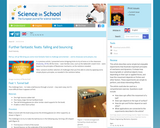
This article provides several challenges that students will be able to solve by applying simple physics principles. Solutions are provided.

This article provides teachers the opportunity to exploit GIS as a resource for addressing geographic phenomena.

Students read an article that explores recent research into the genetics of obesity and then participate in a DNA extraction activity.
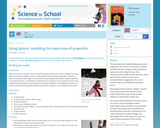
In this lesson, students uses a model to visualize the trajectories of projectiles and investigate horizontal and vertical components of projectile motion.

In this activity, students grow plants hydroponically in the classroom in order to better understand the basic growth needs of plants.

In this investigation, students consider whether there is a relationship between the number of spines on a holly leaf and its height above the ground.

Students use simple liquids that mimic blood to demonstrate blood typing.

In this lesson, students investigate the strong gravitropic response in dandelion flower stalks.

This project starter gives some ideas of ways that structural responses in plants can be explored.

This resource supports the English language development of English language learners. This resource contains an article about ants, explains the life cycle of an ant with pictures, the colony life cycle, and has a coloring page of the life cycle (p.28), among others.

This resource supports the English language development of English language learners. This page has numerous pictures showing complete and incomplete metamorphosis. Some of the organisms included are frogs, butterflies, and mosquitoes. The articles are available in Spanish, also.
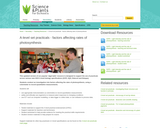
In this inquiry-based lab, students will construct an experimental setup to compare the rate of photosynthesis to the rate of respiration. This will make it possible to perform a quantitative analysis of the rate of photosynthesis under different light intensities.
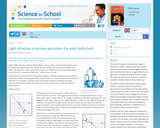
In this lesson, students make a solar bulb out of a plastic bottle and use it to demonstrate refraction.

In this activity, students make the root of a seedling grow through a maze by rotating a petri dish to different angles. When a seed germinates, a root and a shoot appear. Their directional movements are a response to gravity or gravitropism. Primary roots show positive gravitropism as they grow toward gravity.

This simulated experiment allows students to investigate how temperature affects how an animal grows, with application for global climate change. There are three different experiment options, Quick Virtual Lab, Full Virtual Lab, DIY Lab. Each lab allows students to choose which data to see. The Quick Lab limits the number of manduca caterpillars that can be selected. The Full Lab gives students access to all the caterpillar subjects. The DIY Lab also includes all the caterpillars that were raised in a do-it-yourself (DIY) incubator. A Teacher's Resource Packet, containing full instructions for each experiment, student handouts, a sample lesson plan, and background information to help get you started, is also included.
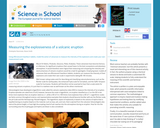
Students model the action of volcanoes to measure the intensity of the explosions and create their own measurement scale.
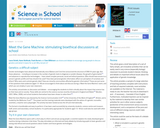
This activity uses drama and debate to encourage students to discuss genetics and what genetic technologies mean for all humans.
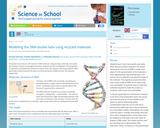
Students learn the basic structural elements of DNA and their 3D molecular organization. Students construct a 3D model of a DNA molecule, using everyday materials.
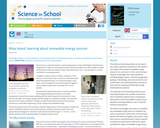
Students consider the energy options available to the four communities living on a fictitious island and select the most appropriate technologies to meet their needs. This activity reinforces students' understanding of renewable energy sources.